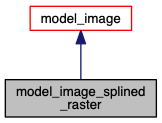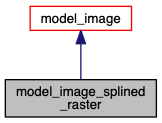model_image_splined_raster Class Reference
Defines a splined raster image for image reconstruction. The raster defined control points for an approximate spline, imposed in the u-v plane. More...
#include "model/model_image_splined_raster.h"
Inheritance diagram for model_image_splined_raster:

Collaboration diagram for model_image_splined_raster:

Public Member Functions | |
| model_image_splined_raster (double xmin, double xmax, size_t Nx, double ymin, double ymax, size_t Ny, double a=-0.5) | |
| Constructs a model_image_splined_raster object. Takes the extents and number of pixels in each directions (xmin and xmax are the locations of the minimum and maximum pixel centers, etc.). | |
| void | use_numerical_visibilities () |
| State switch to select numerically computed visibilities using the machinery in model_image. Once called, all future visibilities will be computed numerically until use_analytical_visibilities() is called. | |
| void | use_analytical_visibilities () |
| State switch to select analytically computed visibilities using the the analytical Fourier transform of the Gaussian. Once called, all future visibilities will be computed analytically until use_numerical_visibilities() is called. | |
| virtual size_t | size () const |
| A user-supplied function that returns the number of the parameters the model expects. | |
| virtual std::string | model_tag () const |
| Return a string that contains a unique identifying tag for use with the ThemisPy plotting features. | |
| virtual void | generate_model (std::vector< double > parameters) |
| A one-time generate function that permits model construction prior to calling the visibility_amplitude, closure_phase, etc. for each datum. Takes a vector of parameters. | |
| virtual std::complex< double > | visibility (datum_visibility &d, double accuracy) |
| Returns complex visibility in Jy computed from the image given a datum_visibility_amplitude object, containing all of the accoutrements. While this provides access to the actual data value, the two could be separated if necessary. Also takes an accuracy parameter with the same units as the data, indicating the accuracy with which the model must generate a comparison value. Note that this can be redefined in child classes. | |
| virtual double | visibility_amplitude (datum_visibility_amplitude &d, double accuracy) |
| Returns visibility ampitudes in Jy computed from the image given a datum_visibility_amplitude object, containing all of the accoutrements. While this provides access to the actual data value, the two could be separated if necessary. Also takes an accuracy parameter with the same units as the data, indicating the accuracy with which the model must generate a comparison value. Note that this can be redefined in child classes. | |
| virtual double | closure_phase (datum_closure_phase &d, double accuracy) |
| Returns closure phase in degrees computed from the image given a datum_closure_phase object, containing all of the accoutrements. While this provides access to the actual data value, the two could be separated if necessary. Also takes an accuracy parameter with the same units as the data, indicating the accuracy with which the model must generate a comparison value. Note that this can be redefined in child classes. | |
| virtual double | closure_amplitude (datum_closure_amplitude &d, double accuracy) |
| Returns closure amplitude computed from the image given a datum_closure_phase object, containing all of the accoutrements. While this provides access to the actual data value, the two could be separated if necessary. Also takes an accuracy parameter with the same units as the data, indicating the accuracy with which the model must generate a comparison value. Note that this can be redefined in child classes. | |
 Public Member Functions inherited from model_image Public Member Functions inherited from model_image | |
| virtual void | generate_complex_visibilities () |
| A one-time generate function that will generate the complex visibilities and store them. This must be called after generate_model has been called. | |
| void | output_image (std::string fname, bool rotate=false) |
| void | get_image (std::vector< std::vector< double > > &alpha, std::vector< std::vector< double > > &beta, std::vector< std::vector< double > > &I) const |
| Provides direct access to the constructed image. Sets a 2D grid of angles (alpha, beta) in radians and intensities in Jy per steradian. | |
| void | get_visibilities (std::vector< std::vector< double > > &u, std::vector< std::vector< double > > &v, std::vector< std::vector< std::complex< double > > > &V) const |
| Provides direct access to the complex visibilities. Sets a 2D grid of baselines (u,v) in lambda, and visibilites in Jy. | |
| void | get_visibility_amplitudes (std::vector< std::vector< double > > &u, std::vector< std::vector< double > > &v, std::vector< std::vector< double > > &V) const |
| Provides direct access to the visibility amplitudes. Sets a 2D grid of baselines (u,v) in lambda, and visibilites in Jy. | |
| void | use_spline_interp (bool use_spline) |
| Provides ability to use bicubic spline interpolator (true) instead of regular bicubic. Code defaults to false. | |
| virtual void | set_mpi_communicator (MPI_Comm comm) |
| Defines a set of processors provided to the model for parallel computation via an MPI communicator. Only facilates code parallelization if the model computation is parallelized via MPI. | |
| void | write_model_tag_file (std::string tagfilename="model_image.tag") const |
| Write a unique identifying tag for use with the ThemisPy plotting features. This calls the overloaded version with the outstream, which is the only function that need be rewritten in child classes. | |
| virtual void | write_model_tag_file (std::ofstream &tagout) const |
| Write a unique identifying tag for use with the ThemisPy plotting features. For most child classes, the default implementation is suffcient. However, should that not be the case, this is the only function that need be rewritten in child classes. | |
Private Member Functions | |
| virtual void | generate_image (std::vector< double > parameters, std::vector< std::vector< double > > &I, std::vector< std::vector< double > > &alpha, std::vector< std::vector< double > > &beta) |
| Sets the image pixel values. | |
| double | cubic_spline_kernel_1d (double k) const |
| double | cubic_spline_kernel (double u, double v) const |
Additional Inherited Members | |
 Protected Attributes inherited from model_image Protected Attributes inherited from model_image | |
| MPI_Comm | _comm |
| bool | _generated_model |
| True when a model is generated with generate_model. | |
| bool | _generated_visibilities |
| True when model visibilities have been computed. | |
| bool | _use_spline |
| True when want to use bicubic spline interpolator. | |
| double | _position_angle |
| Position angle of the image, assumed to be the last element of the parameter list passed to generate_model. Assumed to be in radians and defined E of N. | |
| std::vector< double > | _current_parameters |
| Last set of parameters passed to generate_image, useful to determine if it is necessary to recompute the model. Useful, e.g., if we are varying only position angle, or if recomputing for a number of different data sets at the same set of parameters. | |
| std::vector< std::vector< double > > | _alpha |
| 2D grid of horizonal pixel locations in radians, relative to the fiducial direction of the image (i.e., unrotated by the position angle). | |
| std::vector< std::vector< double > > | _beta |
| 2D grid of vertical pixel locations in radians, relative to the fiducial direction of the image (i.e., unrotated by the position angle). | |
| std::vector< std::vector< double > > | _I |
| 2D grid of intensities at pixel locations in Jy/str. | |
 Protected Attributes inherited from model_visibility Protected Attributes inherited from model_visibility | |
| MPI_Comm | _comm |
 Protected Attributes inherited from model_visibility_amplitude Protected Attributes inherited from model_visibility_amplitude | |
| MPI_Comm | _comm |
 Protected Attributes inherited from model_closure_phase Protected Attributes inherited from model_closure_phase | |
| MPI_Comm | _comm |
 Protected Attributes inherited from model_closure_amplitude Protected Attributes inherited from model_closure_amplitude | |
| MPI_Comm | _comm |
Detailed Description
Generates a rastered pixel array, for which the parameters are the intensities at each pixel. On construction the number of pixels in the two directions are set, setting the resulting number of parameters. An approximate cubic spline is imposed with a control parameter \(a\) that should usually be set to -0.5 (default) to -0.75 to prevent excessive ringing.
Parameter list:
- parameters[0] ........ pixel 0,0
- parameters[1] ........ pixel 1,0 ...
- parameters[Nx-1] ..... pixel Nx-1,0
- parameters[Nx] ....... pixel 0,1
- parameters[Nx+1] ..... pixel 1,1 ...
- parameters[Nx*Ny-1] .. pixel Nx-1,Ny-1
The documentation for this class was generated from the following files:

